Discrete-element numerical simulations of thrust-related folding---Insights into back-limb deformation(Journal of Structural Geology)
[Yang, W., Rao, G., Tang, P., Zhu, C., Wang, R., 2025. Discrete-element numerical simulations of thrust-related folding: Insights into back-limb deformation. Journal of Structural Geology 197, 105442. https://doi.org/10.1016/j.jsg.2025.105442)]
Title
Discrete-element numerical simulations of thrust-related folding: Insights into back-limb deformation
Authors
Wenxiong Yang1, Gang Rao12*, Pengcheng Tang3, Chao Zhu3, Renfu Wang4
- School of Geoscience and Technology, Southwest Petroleum University, Chengdu 610500, China
- CPCIF Key Laboratory of Oil and Gas Geophysical Exploration Technology in Foothill Belts, Southwest Petroleum University, Chengdu 610500, China
- PetroChina Hangzhou Research Institute of Geology, Hangzhou 310023, China
- Exploration and Development Research Institute, Sinopec Southwest Oil & Gas Company, Chengdu 610041, China
- Correspondence author: Gang Rao (raogangss@126.com)
Abstract
The theory of thrust-related folding has significantly enhanced our comprehension of the kinematic evolution of folds, especially those associated with fault ramps. Despite extensive research into the deformation mechanisms of the fore-limb in the hanging wall folds, the factors influencing back-limb deformation remain relatively underexplored. This study employs a series of discrete-element simulations to investigate the evolution of ramp related folding, particularly focusing on the factors governing the development of back-thrusts. Comparative analyses reveal diverse deformation styles within the hanging wall of a ramp fold. Notably, when the upper layer exhibits significantly greater strength relative to the lower layer, and an intermediate décollement exists between them, decoupled deformation occurs, characterized by back-thrusting predominantly in the lower layer. This phenomenon is analogous to the deep thrust belts beneath the Shizigou anticline in the western Qaidam Basin, northern Tibetan Plateau, where multiple hydrocarbon-bearing layers have been identified. The findings offer significant insights into the mechanisms of thrust-related folding, thereby improving efficient hydrocarbon exploration in relevant regions. Furthermore, unlike the commonly reported nucleation of a fault ramp from the basal d ́ecollement or at an intermediate level, our observations indicate initiation from the shallow section. The detailed mechanism underlying such differential deformation warrant further investigation.
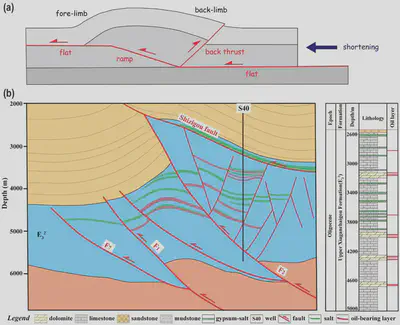
Fig. 1. Fault development associated with ramp-related folding: (a) Schematic diagram showing the formation of a back-limb fault in the hanging wall of a ramp fold; (b) Integrated geological section and stratigraphic column of the western Yingxiong Range structural belt, incorporating seismic reflection and drilling data (adapted from Li et al., 2018).

Fig. 2. The rock-deformation experiment illustrates that back-thrusts were primarily localized within the lower sandstone layer (adapted from Chester et al., 1991).
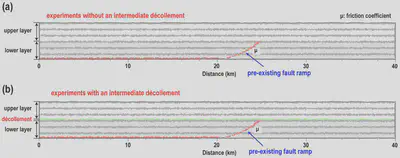
Fig. 3. Distinct initial configurations of the experimental models: (a) direct contact between the upper and lower layers, and (b) separation of the upper and lower layers by a 100-m-thick intermediate décollement. In both configurations, a basal décollement is present in the left half of the model prior to shortening.
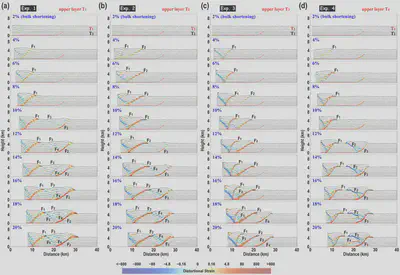
Fig. 4. Results of Experiments 1–4. In the absence of an intermediate d ́ecollement, the lower layer is configured with a bonding parameter set T2, whereas the upper layers are assigned parameter sets T1 through T4 for the Experiments 1 to 4, respectively.
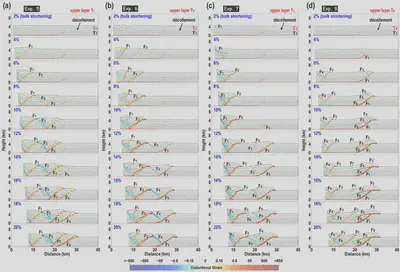
Fig. 5. Results of Experiments 5–8. In comparison with the initial four models (Experiments 1–4), an additional intermediate de ́collement was incorporated in each respective model.
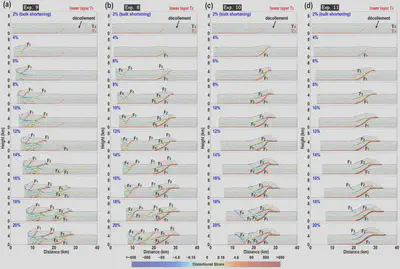
Fig. 6. Results of Experiments 9–11. Following the observation of decoupled deformation in Experiment 8, variations in the strength of the lower layer were examined while maintaining the upper layer at T4. Specifically, the lower layer materials used in Experiments 9, 10, and 11 were set to T1, T3, and T4, respectively.
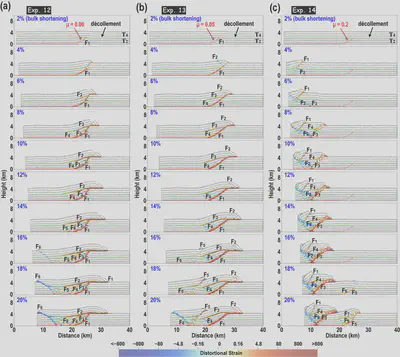
Fig. 7. Results of Experiments 12–14 with variable friction coefficients. In contrast to the coefficient of 0.1 utilized in previous experiments, Experiments 12, 13, and 14 employed coefficients of 0.00, 0.05, and 0.2, respectively.
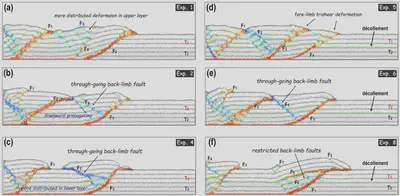
Fig. 8. Comparative analysis of representative models following a uniform 16 % bulk shortening: (a) Experiment 1; (b) Experiment 2; (c) Experiment 4; (d) Experiment 5; (e) Experiment 6; and (f) Experiment 8.
Conclusions
The results of our discrete-element numerical simulations concerning the back-limb deformation during ramp folding lead to the following conclusions. (1) The vertical heterogeneity in stratal strength under ramp folding has a significant influence on the development of back-thrusts. When the upper and lower layers exhibit uniform mechanical properties, a through-going fault is more likely to develop along the axial plane of the fold. Conversely, when there is a disparity in mechanical properties, deformation tends to be more diffuse within the weaker layer. (2) The friction coefficient of the ramp governs the deformation intensity of the hanging wall. A lower ramp friction promotes reactivation of the ramp and facilitates strain propagation along it, leading to folding of the overlying strata and associated fault development. Conversely, higher friction coefficients suppress ramp reactivation, concentrating deformation predominantly in the hinterland region and limiting strain propagation to the ramp position during later stages of evolution. (3) When an intermediate d ́ecollement exists between the upper and lower layers, decoupled deformation results in distinctly different structural styles. Back-thrusting is more localized in strata with uniform strength distribution. In cases where the upper layer exhibits significantly greater strength relative to the lower layer, back-thrusting is confined to the region beneath the intermediate detachment layer. These modelled tectonic characteristics align with the patterns observed in natural examples from the western Qaidam Basin, particularly where back-thrusting associated with the deep fault F2 is confined to the area beneath the Shizigou thrust fault, which developed along the salt layer at the top of the E32 formation.
Acknowledgments
The authors used the ZDEM software (https://geovbox.com/en/) to conduct simulation experiments in this study. We thank Julia Morgan at Rice University for providing her discrete element code (RICEBAL v5.4) and post-processing scripts and algorithms, which have been used to process and display the model outputs presented in our modeling. We express our gratitude to Dr. Chang-Sheng Li for his invaluable suggestions during the numerical simulations. We also thank the editors and two reviewers for their constructive feedback and insightful suggestions, which significantly enhanced the clarity of this manuscript. This study was supported by the National Natural Science Foundation of China (No. 42272271) and the PetroChina Science and Technology Major Project (No. 2023ZZ02).
References
Due to space limitations, please refer to the full list of references:Yang, W., Rao, G., Tang, P., Zhu, C., Wang, R., 2025. Discrete-element numerical simulations of thrust-related folding: Insights into back-limb deformation. Journal of Structural Geology 197, 105442. https://doi.org/10.1016/j.jsg.2025.105442
- Translator: Bao Xianjun